Amazon terminology can be difficult to learn for new sellers and can still be troublesome for veteran sellers to remember. But since we all need to talk the talk to sell the goods, it helps to have a cheat sheet to refer to every now and then.
So many acronyms and terms are used in the Amazon space on a daily basis. Now you won’t be caught scratching your head over unfamiliar lingo on a blog post or Amazon forum.
Here are the most commonly used terms and acronyms organized by groups and in alphabetical order:
Affiliate
An affiliate is a different party who advertises the products or services of another, for a commission. This will bring in more views to your storefront, and in return, you pay out a commission on each sale that comes through that affiliate link.
Affiliate Marketing
An arrangement by which an online seller pays a commission to an outside website for traffic or sales brought in from its referral.
Alibaba

A Chinese eCommerce, retail, and technology platform. For Amazon FBA selling purposes, this is a third party platform between private businesses and global suppliers, wholesalers, and manufacturers. Alibaba is the largest internet shopping center in the world measured by total sales.
Alibaba Assessed Supplier
A manufacturer, supplier, or wholesaler on Alibaba which has been qualified by an accredited third-party inspection company.
Alibaba Gold Supplier
A manufacturer, supplier, or wholesaler that has been pre-qualified by Alibaba.
Alibaba Trade Assurance
A free feature provided by Alibaba that shields buyers and sellers on their purchases from the moment of payment to delivery.
Amazon Advertising or PPC (Pay-Per-Click)
You are charged each time that your Sponsored Product, Sponsored Brand, or Product Display ad is clicked. This is a form of low-risk advertising where you pay based on how well your ad is performing.
ACOS (Average Cost of Sale)
This metric is used in Amazon Advertising to see how well your ads are performing associated with how much you spend for them. It computes how much you spend on average for ads to make a sale. This can be determined per keyword and per campaign. It is calculated by dividing your total ad spend by the amount spent to achieve a sale. ACoS = 100 * (Total Ad Spend ÷ Total Sales).
Ad (Advertising or Advertisement) Terms
Ad Clicks
The number of times ads in a specific set are clicked.
Ad Daily Budget
The average daily amount you are willing to spend on a specific ad set.
Ad Impressions
The total number of times consumers see a displayed ad.
Ad Orders
The total number of single orders made by customers who clicked on your product’s sponsored ad.
Ad Sales
The total product sales made within one week of clicking on your product’s sponsored ad.
Ad Spend
The charges for the total number of clicks on an Amazon sponsored campaign over a certain period of time.
Ad Status
The current standing of your ad group. The status may be: ended, scheduled, incomplete, out of budget, payment failure, or one of the following.
Ad Status: Archived – An ineligible campaign that cannot be paused or enabled.
Ad Status: Paused – An ineligible campaign that will not show in ad placements.
Ad Status: Running – A qualified campaign that will show in ad placements.
Ad Targeting
This option determines whether keywords for an ad campaign are automatically selected by Amazon or by you for an ad campaign.
Ad Types
The types of advertisements that are available on Amazon.
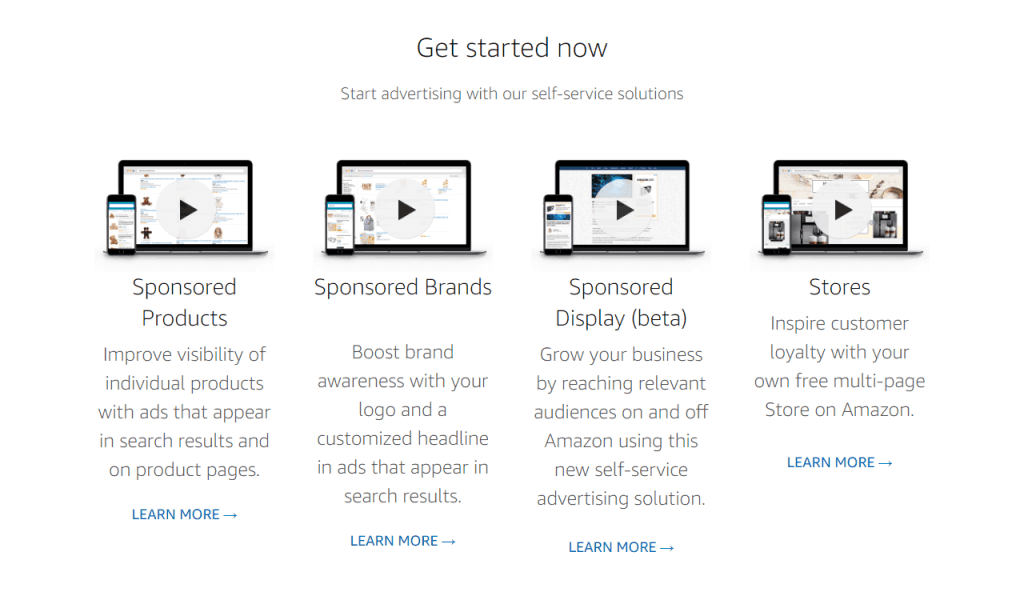
Automatic Targeted Ads
Targeted advertisements that are relevant to search terms automatically created by Amazon and do not require you to input specific keywords.
Headline Search Ad
Amazon ads that appear at the top of search results. To qualify for a headline a search ad, you must have a registered brand a minimum of three products available for that brand.
Manually Targeted Ads
Marketing campaigns where you select the keywords you wish to target.
Product Display Ad
These ads are shown on the top, sides, and bottom of the search results page. This type of advertising is only available to sellers in Amazon’s Brand Registry.
Sponsored Ad
A pay-per-click advertising solution that enables you to promote the products you sell with keyword-targeted ads (manual or automatic) that appear in highly visible placements on Amazon.com.
Sponsored Brands
Allows sellers to promote their products on the top, side and bottom of search result pages. This advertising option is only available to sellers enrolled in Amazon Brand Registry.
Sponsored Products
Your product listing appears on the product search results page before non-sponsored listings. It is one of the most popular ad campaign on Amazon.
Bid+
The Bid+ button allows you to increase bids in a campaign up to 50% more than your max bid when Amazon thinks your ads are eligible to show at the top of search results. This is only for manually targeted Amazon advertising campaigns and won’t take you over your budget.
CoGS (Cost of Goods Sold)
For an Amazon private label product, this may include the cost of materials, packaging, shipping, duty taxes, etc. COGs is the accumulated total of all costs used to create a product or service, which has been sold.
Conversion Rate
This rate is the percentage of prospective buyers that go to your page and then convert into customers by purchasing your product. If you have a high conversion rate, Amazon will place you higher in searches and rankings because of your profitable products. If you have a low conversion rate, you may want to consider optimizing your listings more to attract more sales.
CPC (Cost-Per-Click)
This is a marketing strategy that refers to the price you pay each time a customer clicks on your ad.
CPM/CPI ( Cost-Per-Mil or Thousand / Cost Per Impression )
A marketing strategy that pertains to the price you pay each time 1,000 people view your ad.
SEO (Search Engine Optimization)
The process of increasing the quantity of visitors on a particular website by ensuring that the site appears high on the list of results returned by a search engine. This includes but is not limited to the use of relevant keywords in listings.
Keywords
The keywords or phrases that people type into search engines when looking for relevant results.
Long Tail Keyword – a keyword phrase that contains two or more words.
Negative Keywords – irrelevant to your product search terms and don’t necessarily describe your listing or target audience.
Seasonality – how often and when a keyword for a product is searched within the year.
Top-of-the-Funnel Keywords – short keywords that receive large search volume estimates. They are highly competitive and pull in a lot of products.
Search Engine Position
Refers to the given product’s position on the Amazon search page.
Search Volume
The number of times a keyword is searched in a month on Amazon by all customers. This is important for marketing products and listing new items.
Traffic
Traffic is the number of visitors that come to your store or product listings through multiple avenues. The more traffic you have, the more likely you are to sell products.
Promotions
A series of special discounts and services offered to Amazon sellers to promote sales and social media growth.
BOGO (Buy-One-Get-One Promotion)
A common form of sales promotion which allows customers to purchase two products for the price of one to bring a new product on or to get current customers interested in something different.
Coupons
A promotion that gives discounts to Amazon customers. As an Amazon seller, you may use the coupons to offer discounts on your products.
Free Shipping Promo
An Amazon marketing strategy which allows you to offer free shipping to customers for a limited amount of time.
Giveaway Promo
An Amazon marketing strategy that allows you to offer your products for free to gain interest and build appearance on social media.
Gross Profit
The profit made after the costs of making and promoting an item is deducted.
Lightning Deals
Also known by others as Flash deals. These deals are available for a limited time to customers and at a discounted price. Sellers set what the discount will be and how long the deal will run.
Percentage Off Promo
An Amazon marketing strategy which allows you to discount a product in one or more tiered offerings to encourage customers to buy more.
ROI (Return on Investment)
What you get in return from an investment that you’ve made. Usually refers to the monetary value you get from an investment in a product or in advertising or marketing that product.
Amazon Marketplace
This refers to Amazon as a whole or to specific regions that Amazon caters to, like Amazon North America, Amazon Europe, etc.

A-to-Z Guarantee
Amazon defines the Amazon A-to-Z Guarantee as protection for customers when they purchase items sold and fulfilled by a third-party seller. This guarantee covers both the timely delivery and the condition of your items. Or, as most people refer to it, “Amazon’s amazing return policy.”
A9 Search Engine
An auxiliary of Amazon that evolves and expands search engines and searches advertising technology. A9 influences Amazon’s product discovery and determines which items are the most relevant to the customers query.
A9 Search Algorithm (Amazon Search Algorithm)
Created by the A9 group, who is responsible for giving sense to the unending amount of search queries that happen each month. The main purpose of the search algorithm is to help consumers find products more easily and to help sellers advertise their products on these searches.
Amazon’s Choice
This is awarded to listings based on product ratings, price, and availability to ship. Receiving this reward from Amazon is proven to improve sales.
ASP (Average Selling Price)
The average price that a seller on Amazon can sell their items for. This is computed by taking the total sales for a time period divided by the number of items for the time period.
AZ (Amazon)
An eCommerce platform and cloud computing company based in the United States of America. It is the largest internet shopping center in the world measured by profit and market capitalization.
B2B (Business to Business)
As an Amazon seller, you may qualify to sell products directly to businesses in addition to consumers. This is commonly defined as business conducted with different companies.
Brand Registry
A feature offered by Amazon that helps you register your brand and products. This protects your trademarks on your Amazon products from being copied by fraudulent sellers. It creates a trusted environment for sellers on Amazon. It also gives you access to special features like Enhanced Brand Content and Product Display Ads.
Brand
A name given by a particular company for the products they manufacture.
EBC (Enhanced Brand Content)
If you have enrolled your brand in the Brand Registry, this feature allows you to up your game and give more detailed product descriptions with additional images and text and videos.
Storefront
Allows vendors and sellers to create their own brand stores on Amazon.com and provide their customers with a great shopping experience.
BSR (Best Seller Rank)
This shows how a seller stands up against the competition and shows how well items are doing on Amazon. It is updated on an hourly basis and is calculated to determine top sales of all items sold on Amazon.com. However, it changes frequently. BSR indicates how well a product has sold in the past and how well it has sold in the last few hours. It is best to track this number over time to get an accurate representation of a product’s performance. Items that are ranked on top or optimized according to their category, inventory, and reviews are all shown on BSR.
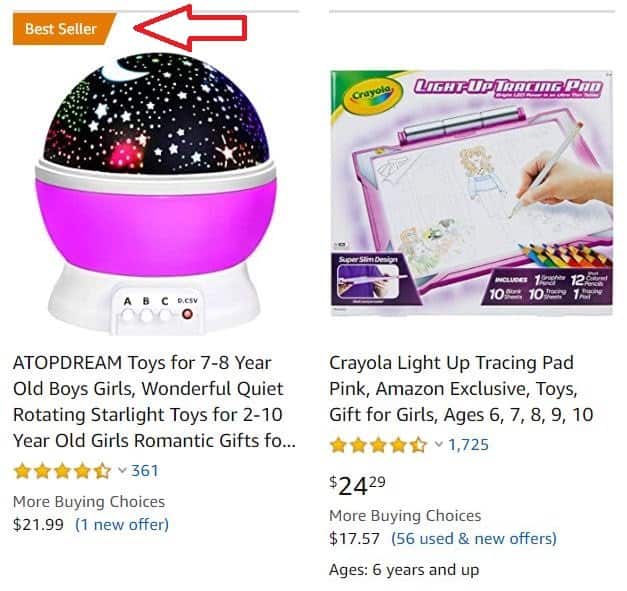
Average Sales Rank
This is the present best-seller rank of products. You can calculate this by adding the best-seller ranking for each product on the search page, then dividing that sum by the total number of available sales.
Buy Box
This is the box located on the right-hand side of a product listing. This contains the product details, shipping information, and purchase details. It also adds a large “Add to Cart” and “Buy Now” buttons on each listing. Amazon has multiple sellers offering the same product, so the stores with the highest standing on Amazon have the chance to “win” this Buy Box. The opportunity given by obtaining the Buy Box can greatly increase traffic and sales to your storefront as it is responsible for a large amount of sales.
Depth
This shows how many letters are required for a keyword to be suggested in the Amazon search bar. It shows how quickly a keyword appears with 1 being the fastest a keyword can appear and 25 being the slowest. (This metric can be found in the MerchantWords database.)
Early Reviewer Program
This encourages customers who have purchased products to leave a genuine description of their experience. This can range between a 1 to a 5-star rating.
FBA (Fulfillment By Amazon)
By sending your product to the designated Amazon warehouse, Amazon is now responsible for preparing shipping out orders to the customers. Amazon has a separate entity with their own fulfillment centers that stores, prepares, and ships your products through Fulfillment By Amazon. Even considering the additional fees, FBA is incredibly helpful when it comes to saving time and being efficient in shipping out products. The best part is that they even handle customer service on behalf of the seller.
FC – Fulfillment Center
A fulfillment center is a large warehouse where products are stored, packed, and shipped on behalf of Amazon and its third-party sellers.
Fulfillment Fee
The amount Amazon charges to pick, pack, and ship your product through its FBA service.
Variable Closing Fee
Fixed charges from Amazon on certain products.
FBM or MF (Fulfillment by Merchant)
This refers to shipping out the items yourself instead of using FBA. The seller is entirely responsible for preparing, shipping the product and customer service for items sold from your Amazon store.
Prime
Amazon Prime is a membership offer for consumers to have special shipping and delivery options. Prime customers are also entitled to discounts, early-bird specials, and more. Prime members are considered “VIP” consumers.
Referral Fee
A percentage-based cost for selling products on Amazon.
Business Model
A design for the successful operation of a business, identifying revenue sources, customer base, products, and details of financing.
OA (Online Arbitrage)
Buying items from online distributors to resell on Amazon.
PL (Private Label)
Putting your own brand name on a generic product and brand it as your own.
RA (Retail Arbitrage)
Buying underpriced items in retail stores to resell on Amazon.
WS (Wholesale)
The buying or selling of products in large quantities at a lower price.
Listing
Your listings are your Amazon products available to customers. It includes your brand, a description, the condition of an item, price, how many you have in stock, ASIN, SKU, and any special offers you set. These listings need to be optimized in accordance with Amazon to rank highly and convert customers.
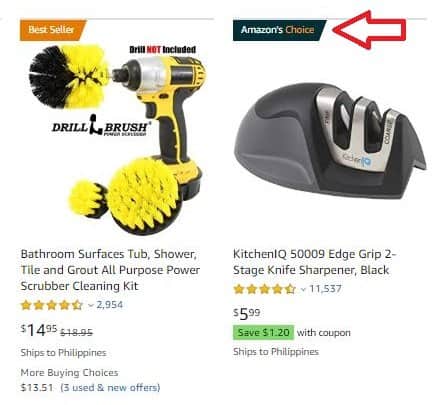
A/B Testing
Also known as “split testing”, this is a method of trying out two different website or product listings to compare each of the metrics against each other, typically conversion rates.
Amazon Condition Guidelines
A metric guided by Amazon to ensure standard quality between new, used, and collectible products.
Barcodes
EAN (European Article Number)
13-digit number for identifying products. Also known as a product ID.
ISBN (International Standard Book Number)
A 13-digit number assigned by standard book numbering agencies to identify individual books.
UPC (Universal Product Code)
A 12 digit number displayed with the barcode on the vast majority of retail products.
Category
Amazon’s product categories are given based on characteristics and uses and places your items in groups similar to each other. A great example of this would be looking at how items are grouped together in your local grocery store. Products may have more than one category placement and one or more sub-category placements which helps customers find what they are looking for with ease.
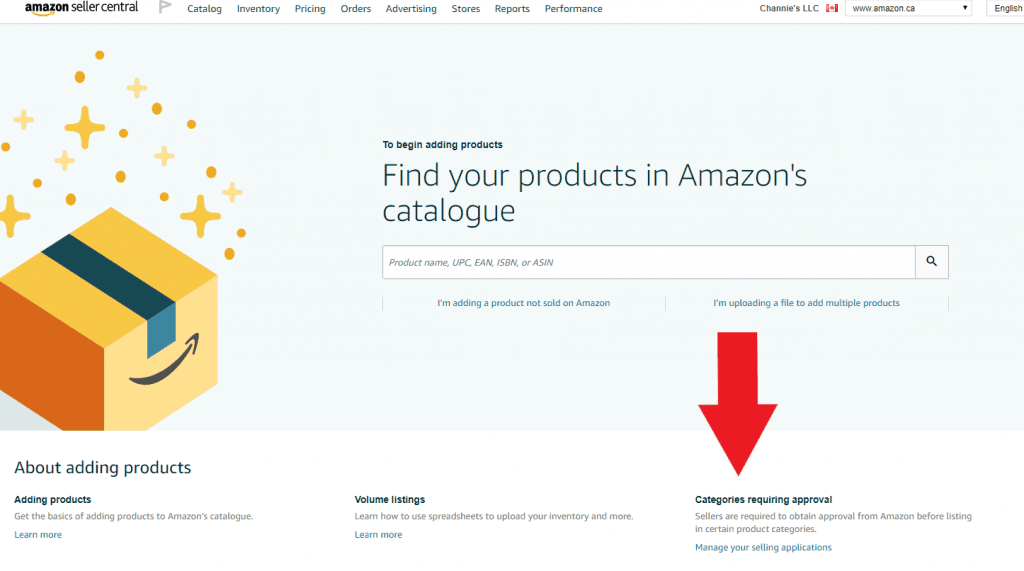
Gated Category
A restricted product being put into a category and locked to sellers without prior approval from Amazon.
Listing Quality Score
A system that considers the length and keyword relevance of a listing’s title, bullet point, description, quality of the pictures. This helps you find products whose listings can be improved and optimized.
Piggybacking
A term for used when there is more than one seller selling on the same Amazon listing. Unless you are enrolled in Amazon Brand Registry, Amazon content ownership is shared. Amazon will fill in details based on what it sees as the best content to display from other similar listings.
Pricing
Average Price
This is the average sales price of products. You can calculate this by adding the lowest sales price for each product on the search page, then dividing that sum by the total number of available items.
MAP (Minimum advertised price)
This is a minimum price given by the supplier in which you agree to sell your items. You cannot sell below the MAP price.
MSRP (Manufacturer’s Suggested Retail Price)
The price you sell your product as suggested by the manufacturer.
PM (Price Match or Private Message)
Most likely refers to matching your price to other sellers. The term also means “private message” which is more commonly used over social media.
Identification Codes (ASINs and SKUs)
Combinations numbers and/or letters used to identify unique products and variations of products.
ASIN (Amazon Standard Identification Number)
Amazon’s internal product number for each listing in their catalog and allows Amazon to locate products. It’s similar to a UPC but is only applicable to Amazon. It consists of 10 alphanumeric digits.
FNSKU (Fulfillment Network Stock Keeping Unit)
A unique way that Amazon identifies a product sent by a seller to an FBA warehouse. Every product that is processed through an FBA warehouse is given this unique identifier.
MSKU (Merchant Stock Keeping Unit)
How Amazon differentiates its FNSKU from the SKU used by a seller listing on the marketplace. Every product listed must have a unique MSKU.
SKU (Stock Keeping Unit)
Used to identify and efficiently manage items in a seller’s inventory.
Logistics
Logistics is the overall management of products in and out of facilities and transporting these products to customers.
Customs Clearance
Passing goods through the official department that collects the taxes given by a government on imported goods.
Duty Tax
Required by a government on imported and exported goods and services.
Marketing
The business process of attracting customers and creating relationships with them to satisfy them; the end goal being to generate sales.
Sales Funnel
Also known as a marketing funnel. It is a customer-centered marketing strategy that illustrates the journey towards the purchase of a product or service.
Landing Page
Also known as the static page or the page that appears in response to clicking a link given by a search result. Ideally, it takes you to the page that represents the next stage in the sales funnel.
Lead Magnet
A free or cheap product offered in exchange for a potential buyer’s contact information, typically any email or phone number.
Opt-in
On opt-in gives a potential customer the option to be connected to or get something from the website.
Sales Page
A web page created for the purpose of enticing customers into making a purchase.
Squeeze Page
A squeeze page is designed to capture opt-in email addresses from potential subscribers.
Sales and Profit
Average Monthly Sales
This is the average sales volume of products. This is calculated by adding the estimated sales made for each product and dividing that by the total number of available entries.
FS – Financial Statements
These are detailed quarter/annual reports of your income which you can request from Amazon. This is where you would be able to see your revenue, losses, and profits during the year.
Margin
The margin, or profit margin, is the profit percentage of a sale taken after the cost of goods and expenses have been deducted.
Net
The profit remaining after all charges or working expenses.
Opportunity Score
It factors in the demand for a product according to how many of them are sold, competition for the item, and listing quality.
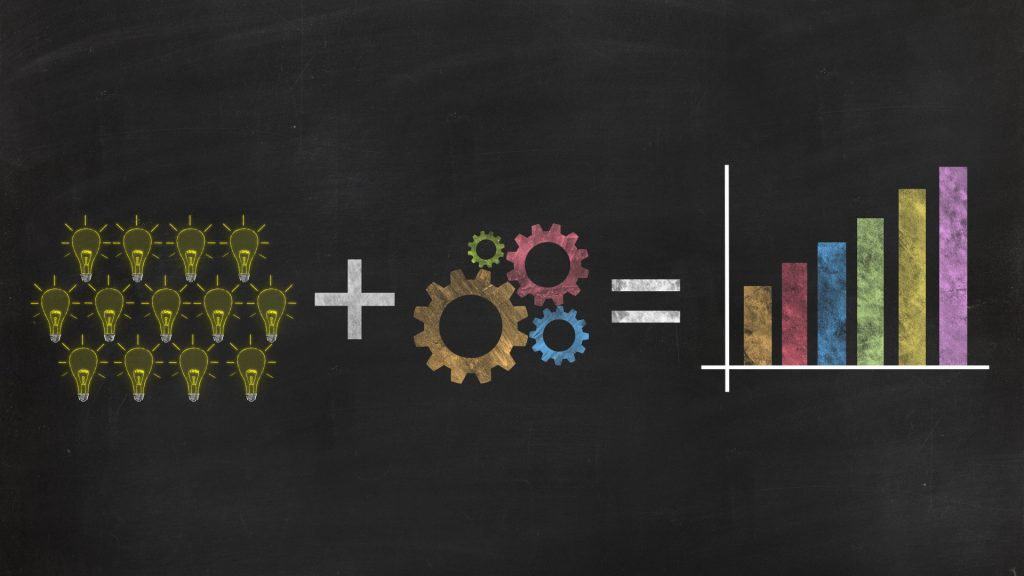
P&L (Profit & Loss Statement)
Also known as the income statement.
Revenue
Income from the sale of products or services.
Sales
The number of items sold over a certain amount of time
Q1, Q2, Q3, and Q4
Refers to the four quarters of the year, namely, January through March, April through June, July through September, and October through December.
Upsell
When a seller promotes products and encourages the customer to purchase more expensive items, upgrades or other add-ons in an attempt to make more sales.
Bump
A sales and marketing strategy to increase the total price of a sale, typically during the checkout page.
SC (Seller Central)
The SC is your home page when you log in to your seller account. Amazon sellers use to this list, maintain, and observe their product’s performance on Amazon.com.
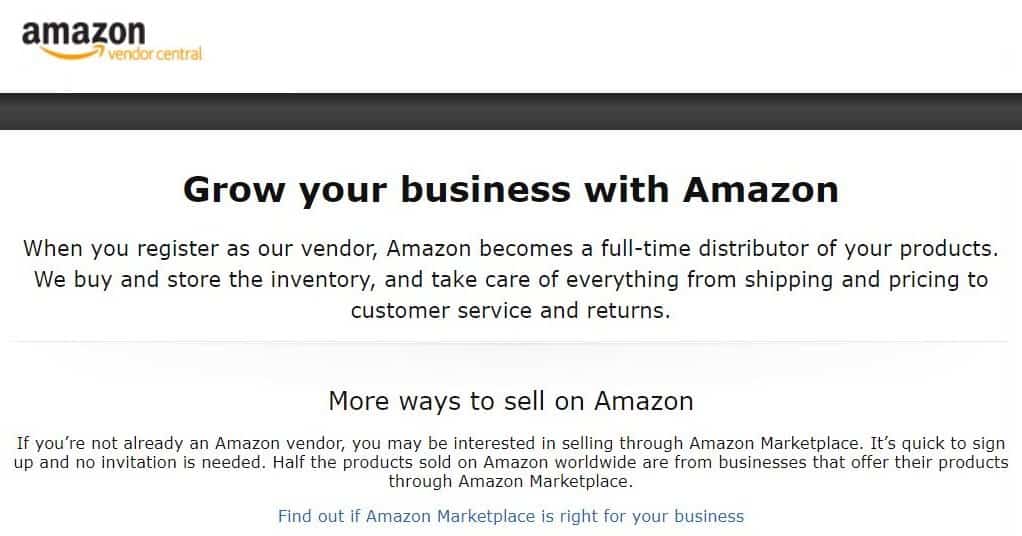
Account Health
A metric for performance goals and standards that all sellers must reach in order to continue selling on Amazon. It is measured by percentage which factors in good customer service, performance, product standards, and shipping performance.
MTD (Month to Date)
A term mostly used when you review targets or sales within the last month.
ODR (Order Defect Rate)
The percentage of orders that incur the most reported issues or negative feedback by customers.
Performance Notifications
A page in Seller Central that updates you on your performance as a seller in respect to Amazon customer satisfaction.
Rating
Each product is rated by customers on Amazon out of five stars. 1 being low and 5 being the highest attainable rating.
Average Reviews – This is the average review count for products calculated by adding the review counts for each product and dividing that by the total number of available reviews.
Unverified Reviews – reviews left for products that have not yet been purchased by the reviewers.
Verified Review – reviews left for products that have already been purchased by the reviewers.

Seller Feedback
A rating given to Amazon’s third party sellers from customers who have recently made a purchase to let other customers know of their experience.
YTD (Year to date)
A term mostly used when you review targets or sales within the last year.
Inventory
This contains the list of stock and products which you have made available for sale on Amazon.
LTH (Long Term Hold)
Keeping inventory to be sold at a later date.
OOS (Out of Stock)
Refers to an item being unavailable for purchase on Amazon.
SS (Seller Support)
Customer service for Amazon sellers.
Suppliers
DS (Drop Shipping)
This is shipping a product from the manufacturer or the supplier directly to the customer. The seller does not hold the stock personally but arranges shipment from the supplier.
Handpicked content for you: Your Complete Guide to Dropshipping
Export
The process of sending goods or services to another country for sale.
Import
The process of bringing goods or services into a country for sale.
Fulfillment
It is the act of receiving goods from a supplier, preparing, branding, and then shipping them to customers. The seller can do fulfillment directly or it can be done through a third-party, similar to drop shipping.
MOQ (Minimum Order Quantity)
The minimum amount you are required to order from wholesale distributors.
Additional read: Amazon MOQs: The Best Tactics to Boost Your Profit Margins
OEM (Original Equipment Manufacturer)
A company that produces parts and equipment that may be marketed by another manufacturer
RFQ (Request For Quote)
An order placed on Alibaba to solicit a request for price estimates on wholesale products.
Replen (Replenish-able product)
An item that a seller is able to replenish from a supplier and sell continuously.
Sample
A single product shipped to a buyer to demonstrate the quality, service, and competence of a manufacturer, supplier, or wholesaler.
Various Acronyms and Terms
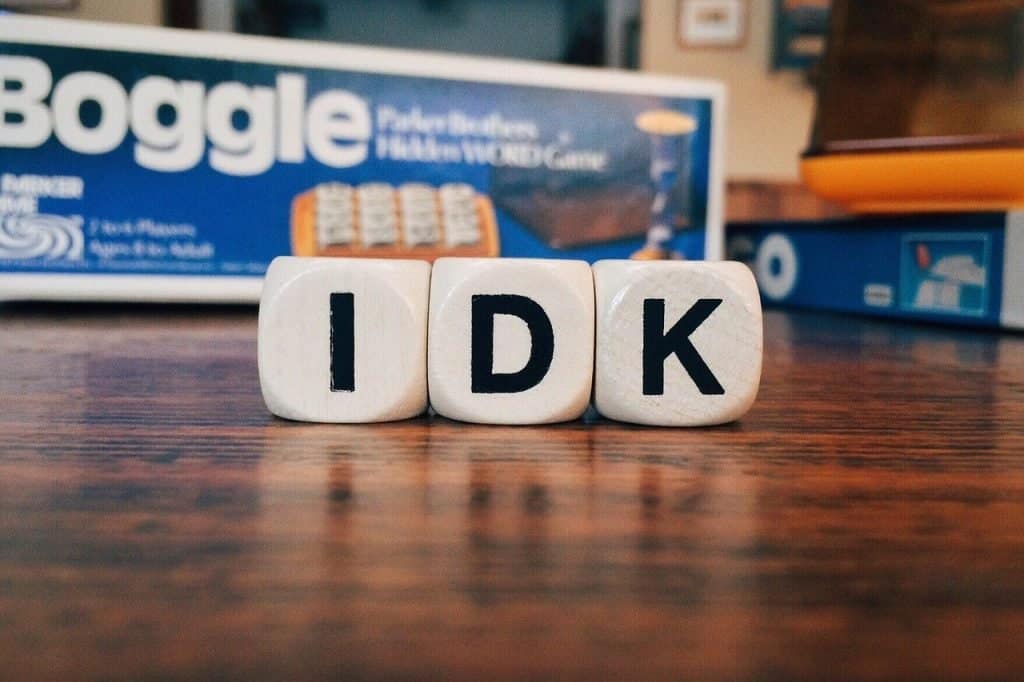
ATOP (At Time of Posting)
Facebook groups connected to Amazon are more than likely to have this. This refers to the pricing of an item at the time the post was made.
BOLO (Be on the Lookout)
This is used to locate an item you desire in stores near you.
FWIW
For what it’s worth
HTF (Hard to Find)
This is often connected to a BOLO post and comes into play when an item is hard to find in stores anywhere.
IMO (In my opinion)
Often used when someone is giving advice for something that they likely don’t want to be taken as 100% reliable. You may also see the variant IMHO, which is in my humble opinion.
TIA
An abbreviation for “thanks in advance”.
VA (Virtual Assistant)
Virtual assistants are generally online assistants that perform various tasks, such as online sourcing or administrative tasks.
YMMV (Your Mileage May Vary)
Related to posts that may not apply to all viewers. Used for deals that may only be offered to a specific group of people or area.
We hope you find this list of terms and acronyms useful.
To more easily locate their meanings when you come across them on the Amazon Marketplace, just use your computer’s “find” function. (Hold down the control key on PC or command key on Mac and press “F” then type or paste what you want to see into the search bar that appears.)
If there’s something that isn’t on this list, contact us and we’ll get it added!



